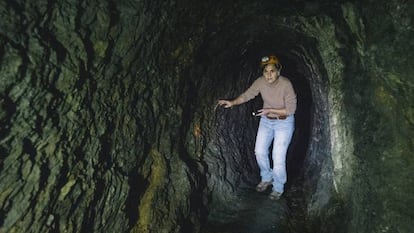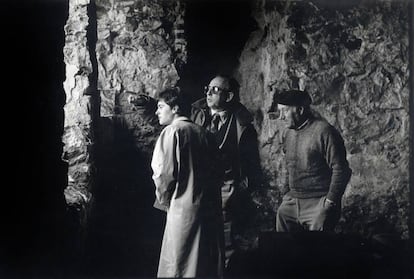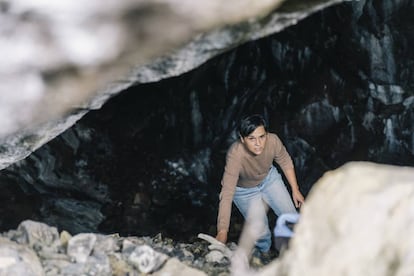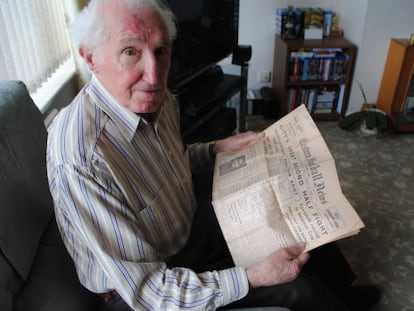The archeologist who discovered Roman ruins in the land of the Basques
Ever since she first explored an astounding mining tunnel in the early 1980s, Mertxe Urteaga has been demonstrating the importance of Roman colonization in the Basque Country, undoing the long-held myth that the small mountainous region resisted the invaders

When she was just 22, the archaeologist Mertxe Urteaga undertook a secret exploration under the Peñas de Aya massif in the Basque province of Gipuzkoa. Taking advantage of a weekend when the workers at the Arditurri mine were resting, she enlisted the help of the geologist Txomin Ugalde and the historian Ricardo Berodia and went underground to investigate a Roman tunnel in a corner of Spain that, in theory, the Romans never conquered.
It was 1982 and the Royal Asturian Mining Company, which was working the Arditurri mine, had just offered local authorities in the town of Oiartzun a “gem”, namely a section of a Roman underground gallery that could be opened to the public. Urteaga, a recent graduate who worked in the municipality’s archives, smelled a rat. She had seen photos taken by the engineers in the mines, she had read reports dating back two centuries, and she suspected that the mining company was offering this “gem,” located in a remote and economically worthless area, to distract attention from what was actually hidden within those mountains – an amazing underground network of passages excavated 2,000 years ago.

“The company was aware of the reports by [the engineers Juan Guillermo] Thalacker in 1803 and [Francisco de] Gascue in 1897 which spoke of a great Roman infrastructure, and indicated the openings of many of those mines,” she explains. “These openings were now being used to get to the seams and to continue mining them. But the company didn’t say anything because they didn’t want archaeologists bothering them. And in the academic world, nobody paid any attention. The myth that the Vascones [considered the ancestors of the Basques] in that mountainous region had managed to fend off the Romans was widespread and used as a key to explain the survival of the Basque language.”
Forty years later, Urteaga, who is herself from the province of Gipuzkoa, guides us through the Arditurri valley to show us the place where she and her companions began to explode the myth. At the foot of the imposing granite slopes of the Peñas de Aya, she slips through a human-sized gallery: it is approximately 1.80 meters high and wide enough for a person to stretch out their arms. The passage is vaulted, which is typical of the Romans, who lit fires to break the rock and then fashioned the tunnels with picks.
“We immediately perceived the Roman hand at work, which was very exciting,” she says, pointing out the spaces where the miners would have placed their oil lamps and the channel that still drains the water coming through the rock. She also says wooden trays, iron picks, waterproof fabrics made from wool and hair as well as miners’ clothes have been found. “The feeling of advancing inside the earth is very intense. You go deep into it and suddenly you discover a human footprint from thousands of years ago,” she adds. “To me this place is awe-inspiring. You can see the meticulous plan to access the seam, where the layout of the passage has been rectified, the slope for drainage. It is a negative construction, a sculptural void. It looks like a work by [the Basque sculptor Jorge] Oteiza.”
After 50 meters, this level gallery connects with a steeply inclined diagonal tunnel that was used by the Roman prospectors. When they found the seam, the surveyors had to determine the level at which they should drill the level gallery where the miners would be working, the one where we are standing now. One theory is that they linked dozens of meters of cat intestines to the outside and filled them with water: this way they could see from the outside the exact level of the underground seam.

The Royal Asturian Mining Company closed the mines in 1984 and left the field free for archaeologists. In Arditurri alone, the latter found more than 40 areas where the Romans had been active, constructing complex works such as a 425-meter underground aqueduct that drained the water filtering through the rock – and continues to do so – allowing miners to work 15 meters below the river. “Four hundred men for 200 years would not have been enough to dig out all these galleries,” wrote Thalacker in 1803.
Archaeologists have since discovered more Roman mines in the area around Peñas de Aya, both in Gipuzkoa and in the adjoining Navarre region, confirming the importance of the area as one of the main producers of silver, iron and copper in the former Roman province of Tarraconensis, which spanned parts of modern-day Spain and Portugal. Convinced that the Roman occupation must have been much more intense than once believed, Urteaga and her colleagues from the archeological research center Arkeolan came across another great find in the heart of Irun, a large town on the border with France.
In 1992, taking advantage of roadwork taking place on Santiago street, Urteaga and her colleagues asked the city council for permission to look for the remains of a Roman harbor. “They were laughing,” she says. “But the excavator, which was taking out piles of black slime, suddenly came up with a good many pieces of Roman pottery. Tremendous! We found thousands of fragments, wooden structures, bits of moorings... It had been a port with docks, warehouses, customs offices, a hub for salted fish from the Eastern Mediterranean, cereals, wine from the Ebro Valley and oil from Baetica [in the south of the peninsula]. Right now, I’m researching my proposal that the port had a vast façade to show the importance of the city.”

Below Irun lay Oiasso, the city of the Vascones people mentioned by the classical geographers, with its port, necropolis and baths that have all been unearthed by archaeologists along with traces of temples and theaters that have yet to come to the light. “Some people came to the excavation and teased us saying, ‘Come on, girls, don’t you know the Romans never got this far?’ A man would come by the dig every day and insult us,” recalls Urteaga.
-Why?
-Some people were uncomfortable with our findings because it spoiled the idea they had of their own identity: ‘The Romans never occupied this country, the Vascones resisted, and that’s why we are a peculiar people with a unique language.’ That myth was very deep-rooted. Some people from the cultural and academic world treated us as if we were committing treason.”
Urteaga maintains that Basque culture did not survive in spite of the Romans, but because of them. “Their army was unstoppable,” she says. “They settled in the regions that interested them and the local leaders probably integrated and took advantage of improved political position, business opportunities and higher standards of living. Thanks to the Romans, they received an accelerated course in modernization. Within a couple of centuries, they had adopted the Latin script, the most advanced techniques of construction and agriculture, urban planning, art, hygiene and everything that other civilizations had developed during thousands of years. Other cultures missed out on this modernization and disappeared.”
The past does not exist, Urteaga maintains. We are always living in the present; it is ideas of the present that shape our vision of the past. Oiasso was the first Roman port on the Iberian Peninsula to be excavated at a time when there were no more than a dozen known sites in the whole world. It was a treasure, but Urteaga and her colleagues had to reveal it in such a way that Basque society would appreciate its value. They provided consistent archaeological evidence and won the support of local public institutions. They gave lectures, opened the Oiasso Museum and, every year, they organize an archaeological film festival and a Roman show festival.
A few years ago, Mertxe Urteaga was chatting on a train with a lady from Irun. “She asked me what I worked in,” she says. “I told her I was an archaeologist and she replied: ‘Ah, you know that Irun was a Roman city, right?’ And I thought, ‘That’s it, we’ve done it.’”
English version by Heather Galloway.
